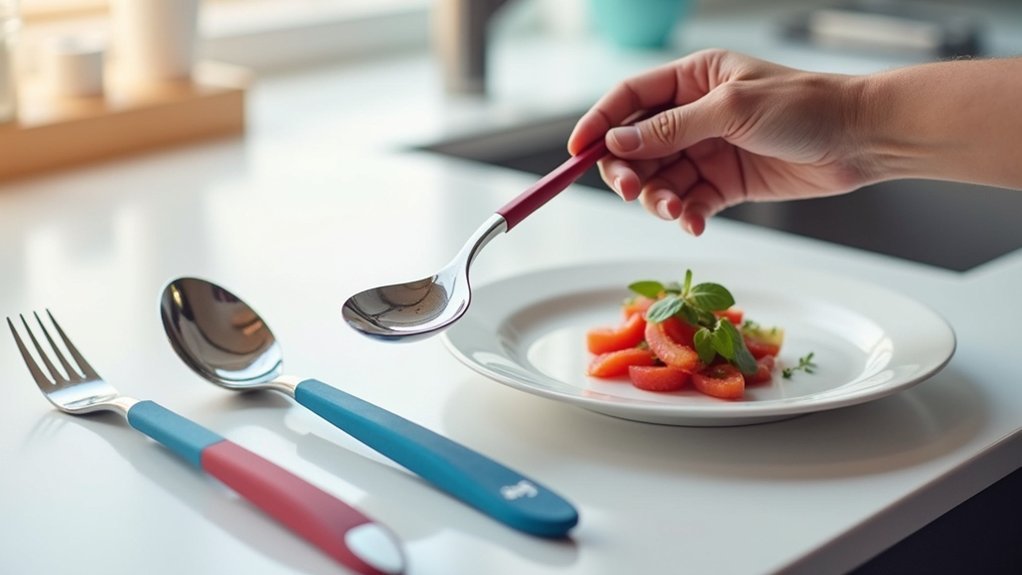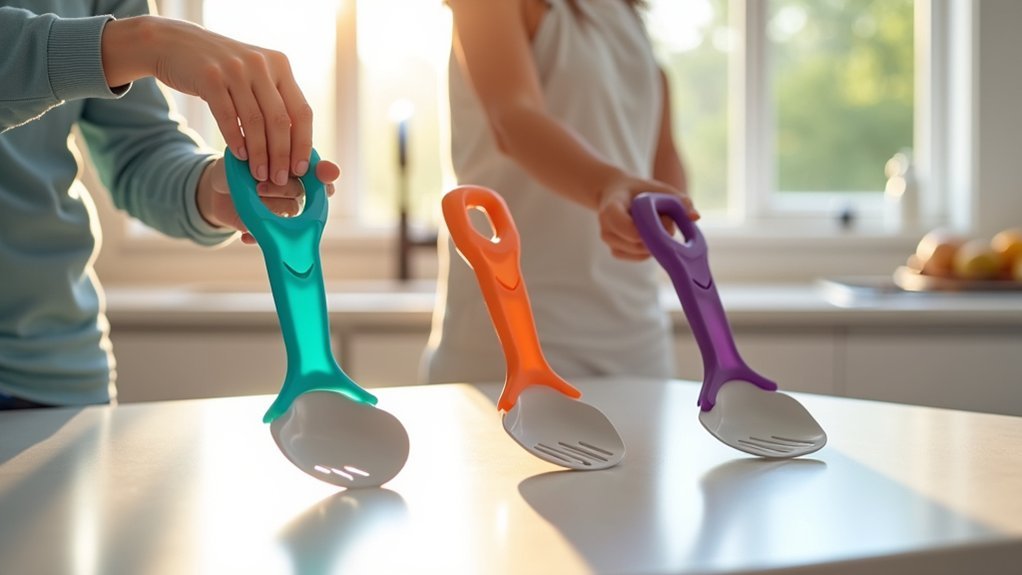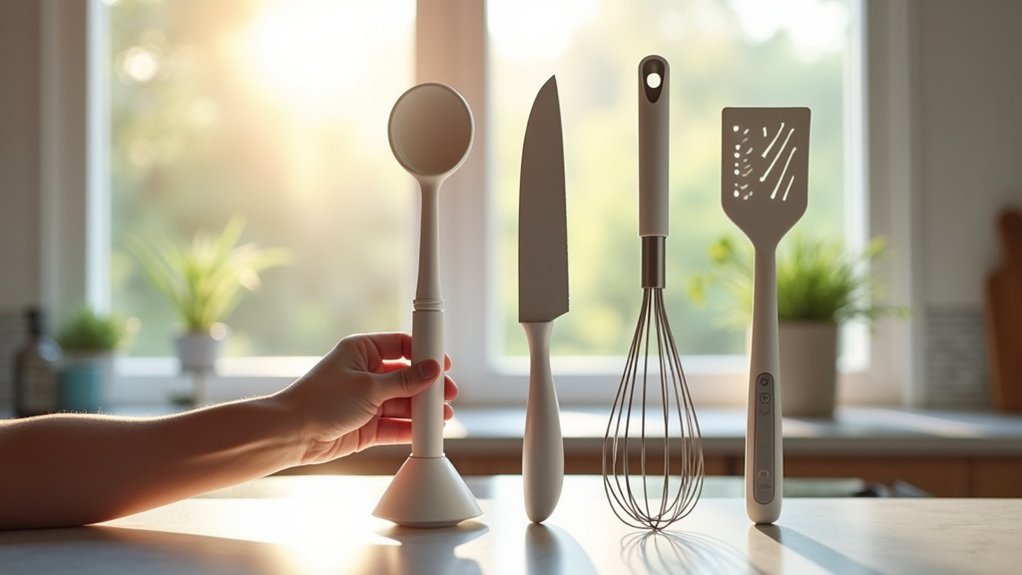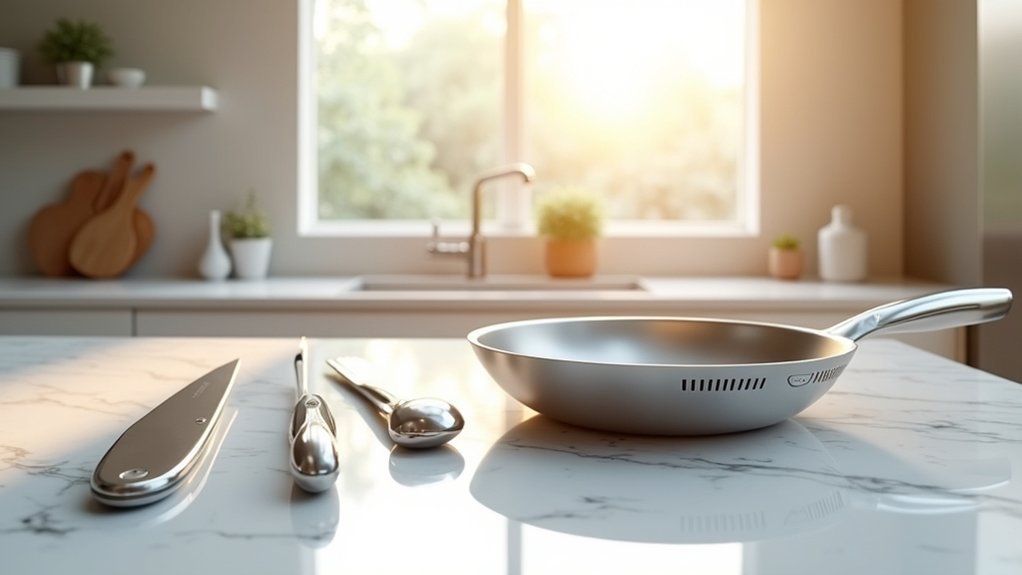You’ve probably struggled with traditional kitchen tools if you or a loved one faces mobility challenges. By 2025, adaptive cooking utensils will transform kitchen independence through groundbreaking innovations. From tremor-stabilizing technology to versatile grip aids, these tools aren’t just functional—they’re life-changing. They’ll help users reclaim cooking joy while preserving dignity. Want to discover which five adaptive utensils will revolutionize kitchen accessibility next year? The innovations might surprise you.
Adaptive Utensils Set for Parkinsons Patients and Hand Tremors

For individuals living with Parkinson’s disease, hand tremors, or limited dexterity, mealtimes can transform from a simple daily activity into a frustrating challenge.
This 4-piece adaptive set features ergonomically designed utensils with a 42° angle that reduces wrist rotation and fatigue. You’ll appreciate the 2.5 oz weighted design that provides stability without causing hand strain, while the textured, non-slip silicone grips enhance control during meals.
Made from dishwasher-safe stainless steel, these utensils are available in both left and right-handed options. Users consistently report increased independence and dignity while dining, though some note the spoons could be deeper for liquids.
Best For: Individuals with Parkinson’s disease, hand tremors, arthritis, or limited dexterity who struggle with conventional utensils during mealtimes.
Pros:
- Ergonomic 42° angled design reduces wrist rotation and fatigue, promoting independent eating
- Weighted (2.5 oz) construction provides stability for trembling hands without causing additional strain
- Large textured handles with non-slip silicone grips improve control for those with limited grip strength
Cons:
- Spoons may be too shallow for effectively handling liquid foods
- Included knife is reportedly dull and may not be sufficient for cutting tougher foods
- May be heavier than standard utensils, which could cause fatigue during longer meals for some users
Adaptive Utensils with Non-Slip Handle for Hand Tremors and Arthritis
Individuals living with hand tremors, arthritis, and limited mobility often struggle to maintain mealtime independence, which is why Ehucon’s adaptive utensils offer a transformative solution. These innovative tools feature a bending design that minimizes wrist movement and a textured, spacious handle for enhanced grip.
Made from durable stainless steel with food-grade silicone handles, these utensils combine functionality with comfort. You’ll appreciate the dishwasher-safe design that prevents food overflow and simplifies cleaning. Available in vibrant colors like purple, green, orange, and pink, they’re designed to stimulate appetite while creating a more positive dining experience. Despite some users noting handle width concerns, these adaptive utensils remain essential for anyone seeking greater autonomy at mealtime.
Best For: Adults with Parkinson’s disease, arthritis, hand tremors, or limited hand mobility who want to maintain independence during meals.
Pros:
- Innovative bending design reduces wrist movement, making eating easier for those with limited flexibility
- High-quality stainless steel with food-grade silicone handles offers durability and comfortable grip
- Available in bright colors that stimulate appetite and create a positive dining experience
Cons:
- Handle width may not be suitable for all hand sizes
- Limited utensil selection compared to standard silverware sets
- May require adjustment period for users transitioning from traditional utensils
Grip Aid for Kitchen Cooking and Daily Living (3-Pack)

People with limited dexterity or hand strength can regain kitchen independence with EazyHold’s versatile 3-Pack Grip Aid. These USA-made silicone holders adapt to various kitchen tools, providing you with better control while cooking.
The pack includes three different sizes that secure utensils for eating, drinking, and food preparation. You’ll appreciate that they’re dishwasher safe and heat-resistant up to 500 degrees, making them practical for daily use. Both weighted and unweighted options guarantee you find the right support for your needs.
Available since April 2024, these adaptive aids transform ordinary kitchen tools into accessible implements, eliminating the need for specialized equipment.
Best For: People with arthritis, limited hand strength, mobility challenges, or dexterity issues who want to maintain independence in the kitchen while cooking, eating, and drinking.
Pros:
- Set of three different sizes accommodates various kitchen tools and utensils for versatile use
- Heat-resistant silicone material (up to 500 degrees) is dishwasher safe for easy maintenance
- USA-made product designed with both weighted and unweighted options to provide customized support
Cons:
- Relatively new product (released April 2024) means limited long-term user feedback
- Higher price point compared to standard kitchen utensils
- May require some trial and error to determine which size works best for specific kitchen tools
Parkinsons Spoon for Tremor Relief with Active Stabilization Technology
Living with hand tremors no longer means sacrificing mealtime independence, thanks to the GYENNO Parkinsons Spoon. This adaptive utensil uses an intelligent chip and high-precision digital motor to detect and counteract hand tremors in real-time.
You’ll regain confidence during meals as the spoon actively stabilizes itself, making self-feeding easier and more dignified. The companion mobile app visualizes your tremor data, enabling you to track patterns and share insights with healthcare providers.
The spoon continuously improves through firmware and algorithm updates via OTA technology. Want to test its effectiveness before committing? Download the GYENNO SPOON APP to conduct a usability assessment.
Best For: Individuals with Parkinson’s disease, essential tremor, or other conditions causing hand tremors who want to maintain independence during meals.
Pros:
- Advanced stabilization technology actively counteracts hand tremors in real-time, making self-feeding significantly easier
- Companion app provides valuable tremor visualization data that can be shared with healthcare providers to inform treatment decisions
- Receives continuous improvements through OTA firmware and algorithm updates, ensuring the device becomes more effective over time
Cons:
- Requires charging and technological familiarity which may be challenging for some elderly users
- Limited to spoon functionality only, requiring separate solutions for other utensils
- May be more expensive than traditional adaptive utensils, though specific pricing isn’t mentioned in the information provided
Amco 4.9 Mezzaluna with Silicone Handle & Stainless Steel Blade
The Amco 4.9 Mezzaluna transforms chopping tasks for those with limited hand strength or dexterity. Its ergonomic design features a non-slip silicone handle and commercial-grade stainless steel blade, allowing you to mince herbs, vegetables, and meats with a simple rocking motion instead of repetitive knife work.
Weighing just 4.8 ounces, this lightweight tool ranks #3 in Mincing Knives with an impressive 4.6-star rating from over 4,000 customers. You’ll appreciate its versatility when chopping nuts, fruits, or even slicing pizza. Plus, it’s dishwasher safe, making cleanup effortless—a thoughtful consideration for users recovering from surgery or managing disabilities.
Best For: This ergonomic mezzaluna is best for individuals with limited hand strength, arthritis, or dexterity issues who need an easier way to chop herbs, vegetables, and other foods without the repetitive motion of traditional knives.
Pros:
- Lightweight design (only 4.8 ounces) with non-slip silicone handle makes it comfortable to use for extended periods
- Versatile tool that works for chopping herbs, vegetables, nuts, meats, and even slicing pizza
- Dishwasher safe for easy cleanup, making it particularly convenient for users with mobility limitations
Cons:
- Single blade design may be less efficient than double-bladed mezzalunas for processing larger quantities
- At 6.5 inches long, it may not be suitable for chopping larger vegetables without cutting them into smaller pieces first
- Relatively high price point compared to standard kitchen knives that perform similar functions
Factors to Consider When Choosing the Most Innovative Adaptive Cooking Utensils

When choosing innovative adaptive cooking utensils, you’ll need to evaluate several critical features including tremor stabilization technology and ergonomic handle design. Your comfort and independence depend on proper weight distribution balance that prevents hand fatigue during meal preparation. Don’t overlook material durability, as high-quality materials guarantee your adaptive tools will withstand daily use and maintain their functionality over time.
Factors to Consider When Choosing Most Innovative Adaptive Cooking Utensils
Selecting the right adaptive cooking utensils can dramatically enhance independence and enjoyment in the kitchen for individuals with mobility challenges. When shopping, prioritize ergonomic designs with angled features that minimize wrist strain and fatigue during meal preparation.
Look for utensils with textured, non-slip handles that provide secure gripping for those with arthritis or tremors. Weighted options offer valuable stability and control, reducing frustration during cooking tasks. Don’t compromise on material quality—choose dishwasher-safe stainless steel and food-grade silicone products that withstand daily use.
Consider the visual appeal as well; utensils in vibrant colors can stimulate appetite and create a more positive dining experience. These thoughtful considerations will help you select tools that truly enhance kitchen independence.
Tremor Stabilization Technology
Revolutionary tremor stabilization technology represents a game-changing advancement for individuals with hand tremors seeking kitchen independence. Equipped with intelligent chips and high-precision digital motors, these adaptive utensils detect and counteract hand tremors in real-time, allowing for controlled movements while eating.
You’ll experience markedly reduced spillage and mess during meals, restoring dignity and enjoyment to your dining experience. The accompanying mobile applications let you visualize your tremor data, helping you track patterns and make informed treatment decisions.
What makes this technology particularly valuable is its ability to evolve through over-the-air updates, ensuring your utensils improve based on your feedback and technological advancements. By enhancing confidence and independence, these smart utensils transform mealtimes from frustrating ordeals into enjoyable experiences you can look forward to.
Ergonomic Handle Design
Thoughtfully designed ergonomic handles stand at the forefront of innovative adaptive cooking utensils, offering critical support for those with limited dexterity or mobility challenges. When selecting these tools, you’ll want to prioritize large, textured grips that reduce hand strain—especially if you’re managing arthritis or Parkinson’s disease.
Look for handles featuring the ideal 42° wrist angle, which greatly decreases rotation and fatigue during meal preparation and eating. Non-slip silicone grips provide the friction needed to maintain control, while weighted options offer stability for those managing tremors.
Don’t overlook the importance of finding the right size and width for your specific needs. The best adaptive utensils come in various dimensions to guarantee comfortable handling, maximizing your independence in the kitchen regardless of your physical limitations.
Weight Distribution Balance
Balance serves as the cornerstone of effective adaptive cooking utensils, with proper weight distribution making the difference between frustration and independence in the kitchen. When evaluating 2025’s most innovative options, you’ll want to prioritize utensils where the center of mass aligns perfectly with your grip.
Well-balanced utensils reduce wrist strain and hand fatigue, allowing you to maintain control throughout meal preparation. This feature proves especially beneficial if you’re managing Parkinson’s or arthritis. The best adaptive tools distribute weight strategically to maximize stability while minimizing effort.
You’ll notice immediate improvements in your cooking confidence when using properly balanced utensils. They’ll enable smoother movements, fewer spills, and greater precision. By choosing tools with ideal weight distribution, you’re investing in both your independence and enjoyment of the cooking process.
Material Durability
Material durability stands as a fundamental consideration when selecting adaptive cooking utensils that will serve you reliably for years. Look for options crafted from stainless steel, which resists rust and maintains structural integrity despite daily use in challenging kitchen environments.
You’ll benefit from utensils featuring food-grade silicone handles, offering both comfortable grip and heat resistance while remaining easy to clean. The best adaptive tools are dishwasher safe, simplifying your cleaning routine without compromising quality.
When investing in adaptive kitchenware, prioritize commercial-grade materials engineered to withstand the rigors of constant use. These materials guarantee your utensils can handle exposure to moisture, heat, and occasional drops. Quality construction pays dividends through extended lifespan, making your independence in the kitchen a lasting reality.
Grip Texture Options
The right grip texture transforms an ordinary cooking utensil into a powerful tool for independence. When selecting adaptive utensils, you’ll want to take into account grip options that match your specific needs. Non-slip silicone handles offer excellent friction for those with hand tremors or limited mobility, greatly reducing the risk of accidents during meal preparation.
Look for food-grade silicone grips that provide both security and comfort, minimizing hand strain during extended use. Various textures and widths accommodate different hand sizes and strength levels—what works for someone with arthritis might differ from what’s ideal for someone with tremors.
Don’t overlook the impact of color and texture on your dining experience; brightly colored, textured handles can stimulate appetite while providing visual cues that enhance usability and create a more enjoyable mealtime atmosphere.
Cleaning Ease
When considering adaptive cooking utensils, cleaning ease becomes a crucial factor that directly impacts long-term usability and independence. You’ll appreciate that many adaptive utensils are dishwasher safe, withstanding temperatures up to 248℉, which greatly simplifies your cleanup routine.
High-quality materials like stainless steel resist staining and odors, guaranteeing your utensils remain hygienic with minimal effort. The soft silicone handles found on many adaptive tools can be quickly wiped down with soap, preventing food buildup in hard-to-reach areas.
Look for designs that minimize food overflow during use—this thoughtful feature reduces mess and subsequent cleaning time. Smooth surfaces and non-slip grips aren’t just easier to handle while cooking; they’re also easier to clean thoroughly. These cleaning-friendly characteristics guarantee your adaptive utensils remain practical tools for maintaining independence in the kitchen.
Versatility Across Tasks
Truly versatile adaptive cooking utensils transform your kitchen experience by addressing multiple tasks with a single tool. When choosing innovative options, look for designs that seamlessly shift between cutting, stirring, and serving functions, reducing the need for multiple specialized tools.
The best adaptive utensils feature ergonomic designs that minimize wrist movement while maximizing functionality—perfect if you’re managing conditions like arthritis or Parkinson’s. You’ll find weighted handles with textured grips particularly useful, as they provide confident control across various cooking activities.
Consider options that prevent food overflow, ensuring cleaner meal preparation from start to finish. Colorful designs aren’t just aesthetically pleasing—they can stimulate appetite and make your cooking routine more enjoyable. This multi-purpose approach means fewer tools to manage while maintaining independence throughout the entire cooking process.
Frequently Asked Questions
How Do I Clean Adaptive Utensils With Electronic Components?
You’ll want to wipe electronic adaptive utensils with a damp cloth, never submerge them in water. Remove detachable parts for washing separately, and always check manufacturer’s instructions for specific cleaning recommendations for your devices.
Are These Utensils Covered by Insurance or Medicare?
Many adaptive utensils are covered by Medicare Part B as durable medical equipment or through private insurance with a doctor’s prescription. You’ll need to get documentation of medical necessity from your healthcare provider.
Can Children With Developmental Disabilities Use These Adaptive Tools?
Yes, children with developmental disabilities can use these adaptive tools. You’ll find many are designed with adjustable features, colorful grips, and simplified functions that support developing motor skills and promote independence during meal preparation.
What’s the Average Lifespan of Battery-Powered Adaptive Utensils?
You’ll typically get 1-3 years from battery-powered adaptive utensils, depending on usage frequency and battery quality. With proper care and rechargeable options, you’ll extend their lifespan considerably beyond standard disposable batteries.
Do Restaurants or Public Spaces Provide These Adaptive Utensils?
You’ll rarely find adaptive utensils in most restaurants, though some forward-thinking establishments do offer them. Public spaces like senior centers or disability resource facilities often provide these tools upon request.





Leave a Reply